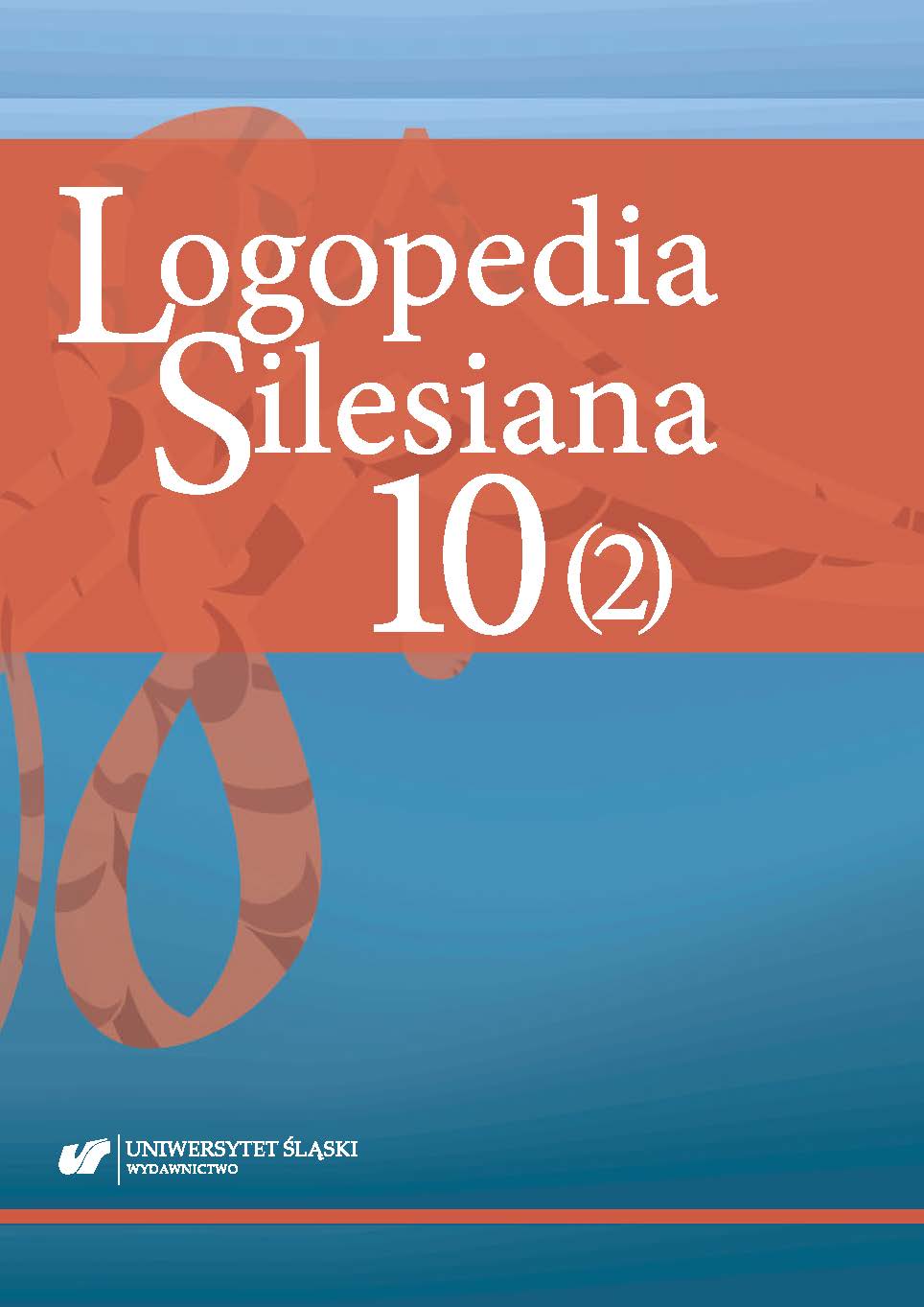Bauman-Waengler, J. (2012). Articulatory and phonological impairments: a clinical focus. Boston, MA: Pearson Education.
Google Scholar
Bee Chin, N., Wigglesworth, G. (2007). Describing bilingualism. W: N. Bee Chin, G. Wigglesworth (eds.), Bilingualism. An advanced resource book (s. 3–18). London: Routledge.
Google Scholar
Billewicz, G., Zioło, B. (2012). Kwestionariusz badania mowy. Kraków: Impuls.
Google Scholar
Błasiak-Tytuła, M. (2017). Kształtowanie się i rozwój mowy dziecka dwujęzycznego. W: E. Jeżewska-Krasnodębska, B. Skałbani (red.), Diagnoza i terapia w pracy logopedy i nauczyciela terapeuty: konteksty teoretyczne i praktyka (s. 247–256). Kraków: Impuls.
Google Scholar
Błasiak-Tytuła, M. (2018). Terapia logopedyczna dwujęzycznego dziecka z autyzmem. Studia Pragmalingwistyczne, 10, 197–208.
Google Scholar
Błasiak-Tytuła, M. (2019). Mowa dzieci dwujęzycznych. Norma i zaburzenia. Kraków: Wydawnictwo Naukowe Uniwersytetu Pedagogicznego.
Google Scholar
Błasiak-Tytuła, M, Orłowska-Popek, Z. (2017). Technika programowania języka (pierwszego i drugiego) w pracy z dzieckiem bilingwalnym. W: M. Rutkiewicz–Hanczewska, J. Sławek, E. Kaptur (red.), Mózg – język – komunikacja (s. 41–54). Poznań: Rys.
Google Scholar
Bryndal, M. (2013). Fonologiczna interpretacja procesów doskonalenia wymowy dziecięcej na tle współczesnych teorii fonologicznych. Gliwice: Fonem.eu.
Google Scholar
Cheng, L. (1997). Diversity: challenges and implications for assessment. Journal of Children’s Communication Development, 19(1), 55–62.
Google Scholar
Cheng, L. (2007). Improve your assessment of bilingualclients with communication disorders. Therapy Insider, 37, 10.
Google Scholar
Cieszyńska-Rożek, J. (2012). Rozwój mowy polskich dzieci na obczyźnie – zjawiska normatywne czy zaburzenia rozwojowe? W: M. Michalik, A. Siudak, Z. Orłowska-Popek (red.), Diagnoza różnicowa zaburzeń komunikacji językowej (s. 67–82). Kraków: Collegium Columbinum.
Google Scholar
Cieszyńska-Rożek, J. (2014). Zaburzenia rozwoju języka polskich dzieci za granicą. W: D. Praszałowicz, M. Łużniak-Piecha, M. Kulpińska (red.), Młoda polska emigracja w UE jako przedmiot badań psychologicznych, socjologicznych i kulturowych. http://www.euroemigranci.pl/dokumentacja.html [data dostępu: 1.06.2021].
Google Scholar
Czaplewska, E. (red.). (2018). Logopedia międzykulturowa (s. 209–234). Gdańsk: Harmonia.
Google Scholar
De Lamo White, C., Jin, L. (2011). Evaluation of speech and language assessment approaches with bilingual children. International Journal of Language & Communication Disorders, 46(6), 613–662.
Google Scholar
Dębski, R., Młyński, R., Redkva, M. (2020). The phonological skills of bilingual preschool children speaking Polish and Ukrainian in Poland. International Journal of Bilingual Education and Bilingualism. https://doi.org/10.1080/13670050.2020.1791047.
Google Scholar
Gaweł, K., Langdon, H., Węsierska, K. (2015). Współpraca polskiego logopedy z tłumaczem – potrzeby, możliwości i perspektywy. Neurolingwistyka Praktyczna, 1, 50–65.
Google Scholar
Goldstein, B., Kohnert, K. (2005). Speech, language, and hearing in developing bilinguals: Current findings and future directions. Language, Speech, and Hearing Services in Schools, 36, 264–267.
Google Scholar
Gutierrez-Clellen, V., Peña, E. (2001). Dynamic assessment of diverse children. Language, speech, and hearing services in schools, 31(4), 212–224.
Google Scholar
Jaroszewicz, M. (2018). Migracje z Ukrainy do Polski. Stabilizacja trendu. Warszawa: Ośrodek Studiów Wschodnich.
Google Scholar
Jassem, W. (2003). Polish. Journal of the International Phonetic Association, 33(1), 103– 107.
Google Scholar
Kohnert, K., Medina, A. (2009). Bilingual children and communication disorders. A 30-year research
Google Scholar
retrospective. Seminars in Speech and Language, 30(4), 219–233.
Google Scholar
Kohnert, K. (2013). Language disorders in bilingual children and adults. San Diego: Plural Publishing.
Google Scholar
[Korol, A.] Король, A. (2017). Мовленнєва картка з картинками. Логопедичне обстеження рівня мовленнєвого розвитку дитини. Тернопіль: Мандрівець.
Google Scholar
Langdon, H. (2002).Interpreters and translators in communication disorders. California: Thinking-Publication.
Google Scholar
Langdon, H., Cheng, L. (2002). Collaborating with interpreters and translators: A guide for communication disorders professionals. Eau Claire, WI: Thinking Publications.
Google Scholar
Langdon, H., Gaweł, K., Węsierska, K. (2018). Diagnozowanie zaburzeń w komunikacji językowej u osób bilingwalnych–praca w zespole logopedy i tłumacza. W: E. Czaplewska (red.), Logopedia międzykulturowa (s. 209–234). Gdańsk: Harmonia.
Google Scholar
Langdon, H., Saenz, T. (2016). Working with interpreters and translators. San Diego: Plural Publishing Inc.
Google Scholar
Lidz, C., Peña, E. (1996). Dynamic assessment: the model, its relevance as a nonbiased approach, and it’s application to Latino American preschool children. Language, Speech, and Hearing Services in Schools, 27(4), 367–372.
Google Scholar
Łobacz, P., (1996). Polska fonologia dziecięca. Studia fonetyczno-akustyczne. Warszawa: Energeia.
Google Scholar
Młyński, R., Redkva, M. (2019). Diagnoza logopedyczna kompetencji językowych u wielojęzycznych dzieci z Ukrainy. Logopedia Silesiana,8, 282–294. https://doi.org/10.31261/LOGOPEDIASILESIANA.2019.08.18.
Google Scholar
Paul, D., Ashby, T., McNielly, L., Ritch, S. (2021). Support personel in audiology and speech language pathology. W: M. Hudson, M. Deruiter (eds.), Professional issues in speech language pathology and audiology (s. 249–227). San Diego: Plural Publishing,
Google Scholar
Peña, E., Quinn, R., Iglesias, A. (1992). The application of dynamic assessment: a nonbiased procedure. Journal of Special Education, 26(3), 269–280.
Google Scholar
Pert, S., Bradley, B. (2018). Clinical Guidelines for Speech and Language Therapists: Bilingualism. Working with bilingual clients/patients with speech, language and communication needs. https://www.rcslt.org/clinical_resources/bilingualism/bilingualism_overview [data dostępu: 7.06.2021].
Google Scholar
Pluta-Wojciechowska, D. (2017). Dyslalia obwodowa. Diagnoza i terapia logopedyczna wybranych form zaburzeń. Bytom: Ergo-Sum.
Google Scholar
Pompino-Marshall, B., Steriopolo, E., Żygis, M. (2017). Ukrainian. Journal of the International Phonetic Association, 47(3), 349–357.
Google Scholar
Syrnyk, M. (2017). Polityka oświatowa wobec migrantów – dzieci i uczniowie z Ukrainy w Polsce. Acta Politica Polonica, 2(40), 53–72.
Google Scholar
[Szeremet, M.K.] Шеремет, M.K. (red.), (2014). Логопедія. Підручник. Київ: Слово.
Google Scholar
Tarkowski, Z., Majewska-Tworek, A. (2018). Terapia logopedyczna dziecka dwujęzycznego. W: A. Domagała, U. Mirecka (red.), Metody terapii logopedycznej (s. 261–286). Lublin: Wydawnictwo Uniwersytetu Marii Curie-Skłodowskiej.
Google Scholar
Tarkowski, Z., Wiewióra, D. (2017). Bilingwizm a rozwój mowy dziecka. W: S. Milewski, K. Kaczorowska-Bray, B. Kamińska (red.), Studia logopedyczno-lingwistyczne: księga jubileuszowa z okazji 70-lecia Profesora Edwarda Łuczyńskiego (s. 109–129). Gdańsk: Harmonia.
Google Scholar
Ukrainetz, T., Harpell, S., Walsh, C., Coyle, C. (2000). A preliminary investigation of dynamic assessment with native American kindergartners. Language, Speech and Hearing Services in Schools, 31, 142–154.
Google Scholar


 https://doi.org/10.31261/LOGOPEDIASILESIANA.2021.10.02.02
https://doi.org/10.31261/LOGOPEDIASILESIANA.2021.10.02.02

 10.31261/LOGOPEDIASILESIANA
10.31261/LOGOPEDIASILESIANA